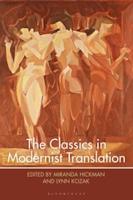
Bloomsbury (2019) h/b 288pp £85 (ISBN 9781350040953)
The literary movement known as ‘modernism’ emerged after the First World War as a reaction to traditional modes of thought and expression. Ezra Pound (1885-1972) and ‘H.D.’ (Hilda Doolittle (1886-1961) were early North American proponents. T.S. Eliot (1888-1965), W.B. Yeats (1865-1939) and James Joyce (1882-1941) were more widely followed in England and Ireland. All assumed a readership familiar with the Classics. How the poets engaged with the original texts is of interest to a growing number of reception scholars.
The Classics in Modernist Translation is a series of essays by over 20 contributors seeking to shed light on this topic. The volume is divided into three parts. Part 1 covers ‘Ezra Pound on Translation’. Part 2 discusses H.D.’s translations of Euripides; and Part 3 is entitled ‘Modernist Translation and Political Attunements’, and includes essays on Laura Riding, Eliot, Joyce, and Yeats. Each section is followed by a ‘Respondent Essay’ with ‘mediation’ by a senior academic. The collection stimulates the reader to discover or rediscover modernist writers, and to put them in the context of today.
The last two sections are the most interesting and successful. Part 2 is of particular interest to those who are interested in the development of the feminist movement. H.D. rejected the racism of her former friend Pound and became a patient of Sigmund Freud. As four strong essays demonstrate (including one by a working poet Catherine Theis), H.D.’s oeuvre included evocative translations of Euripides Ion and Hippolytus, and a recreation of Helen in Egypt. The book’s editors note how, in the first strophe of the Hippolytus, H.D.’s translation choices of ‘veils’ and ‘scarlet’ frame ‘eros’ with ‘societal discourses of shame’:
ὅθι μοί τις ἦν ϕίλα
πορφύρεα φάρεα
ποταμίᾳ δρόσῳ
τέγγουσα, θερ-
μᾶς δ’ ἐπὶ νῶτα πέτρας εὐ-
αλίου κατέβαλλ’…
At high tide,
the sea – they say –
left a deep pool
below the rock-shelf:
in that clear place
where the women dip their water-jars,
my friend steeped her veils
and spread the scarlet stuff
across the hot ridge.
Elsewhere, they point to H.D. exploring the dichotomy between Artemis (Diana) and Aphrodite (Venus), revealing her pain at female hurt and her courage in confronting her own sexuality.
In Part 3, Annet Jessop (Texas) writes perceptively of Laura Riding, the long-term partner of Robert Graves and another first-wave feminist, whose novels, like A Trojan Ending (1937), challenged the passive role of women by reconstructing their lives in classical myth. Other essays explore the interpretations by James Joyce in Ulysses and T.S. Eliot in The Waste Land of the Siren songs in the Odyssey (12.184-91), and relate these works to the cultural despair after the First World War. Matthew Somers discusses Eliot’s jazz-play Sweeney Agonistes and makes much of the Aristophanic plot structures described by F.M. Cornford in The Origin of Attic Comedy. The debt to Aristophanes is properly noted, but Sweeney’s premier was at Vassar in 1933 and Cornford’s book was not published by CUP until 1934.
Occasionally, the conclusions are flawed by over-writing. Joyce and Eliot made use of the Siren songs, but it is questionable whether Homer’s text liberated modernist audiences from the dangers of knowledge or ambiguity. In exploring Yeats’s adaptation of Oedipus Tyrannus, the author incorrectly attributes the source translation to Jebb and Verrall (Verrall simply rewrote the choruses for the Cambridge University production of 1883), but the point about Yeats’s Irish distaste for Oedipus’s political blindness is well made: the Thebans were deceived by a heroic ideal and a national vision.
The section on Ezra Pound is arguably the least successful. His poetry introduced new economy and rhythm into the genre, as well as a rich shorthand of classical references. Two essays demonstrate usefully that Pound used a Homeric translation by the 16th-century Latinist Andreas Divas. A third essay on Pound makes broader claims, suggesting that in his long poem Hugh Selwyn Mauberley (1920), he ‘subverts the prosody of Homer’s text and undermines the narratives of Odysseus and Homer’. This argument is not helped by three ‘illustrative passages’. Pound’s omission of the last word in ἐνὶ Τροίῃ εὐρείῃ (Odyssey 12.189 = Mauberley 1.9) seems not so much a clever ‘provocation’, as an abbreviated quotation which achieves a rhythmic fit and rhyme between ‘Τροίῃ’ and ‘lee-way’. Pound’s inversion τίν’ ἄνδρα, τίν’ ἥρωα, τίνα θεόν, (adjusted from Pindar Olympian 2.2 in much the way as Horace in Odes 1.12) creates a witty rhyme with ‘a tin wreath upon’. The rhythmic conclusions based on Bion’s Lament for Adonis are marred by writing Ἄδωνις as Ἄδονις and miscopying the hexameters which should read:
χὢ μὲν ὀϊστώς,
ὃς δ’ ἐπὶ τόξον ἔβαλλεν, ὃ δὲ πτερόν, ὃς δὲ φαρέτραν.
This is a fascinating collection, with some thoughtful and stimulating material, but occasional lapses in rigour. As the final mediator Nancy Worman (Columbia) writes: ‘The ultimate challenge of the reception of classical literature [is] how to engage with and re-inhabit its aesthetics without reproducing its political limitations or using it to promote those of one’s own era.’
Stuart Lyons
